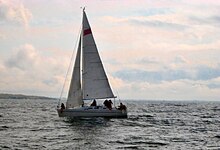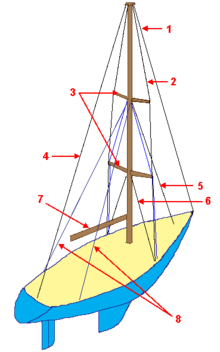Standing good
When standing rigging or Stag those parts of the rigging of sailing ships or boats, which boasts referred to as bracing to stiffen the poles serve. The name is explained by the fact that these are usually not moved during maneuvers . There are, however, exceptions to this rule, such as backstays or additional forestays, which are set when necessary (and are therefore definitely "movable"). Thanks to these guy lines, masts (including these guy lines) can be built more easily, are guyed stiffer and more resilient.
Masts without standing rigging can therefore only be found on smaller dinghies with only one sail; The condition is that they are rigidly anchored in the fuselage. The simplest mast construction, for example in the Sportyak II, is a steel tube that is supported in a hollow in the bottom of the fuselage and is lashed at its tip by 3 steel cables to the bow and side walls at an angle downwards so that these cables roughly form the edges of an equilateral three-sided pyramid .
In addition to the standing rigging, there is the moving rigging , i.e. the rope that is usually moved. - The plurality of Stag is optionally Stage or shrouds .
Some Stage can serve at the same time in addition to the tensioning of the poles for mounting of sails, for example forestay, inner forestays ( cutterstay , s. U.) Or Besanstag .
The masts commonly used in yacht construction today, which are relatively flexible, allow the sails to be trimmed using the tension of the standing goods.
used material
The first stage consisted of natural fibers such as hemp , sisal or coconut . Wire ropes were also used later, chains were only used for a few parts of the standing goods, e.g. B. for the bowsprit ring that supported the bowsprit towards the bow. The standing rigging is still partly dressed and clad on traditionally sailed ships in order to be better protected against the elements. In this case it appears dark brown to black in contrast to the running good.
Today's yachts usually use wire ropes or round rods (so-called rod rigs ) made of stainless steel. Modern regatta yachts have recently started using high-strength ropes made of synthetic fibers or rods made of CFRP .
Stage

As Stage all bracing are referred to in the longitudinal direction of the ship. On ships without a backstay, a stay also means a forestay.
- The stage in detail
- Forestay (1) or jib stay , holds a mast or a rod from the bow.
- Backstay (4), holds the mast out from the stern.
- Jump tag with jump tag brace (the jump tag brace is a spreader )
- Baby day (5): Short stage in front of the mast, below the lower spreader. Also referred to as a cutter stay or inner forestay , if another headsail can be set on them.
- Backstays (8) generally hold a mast from aft, in particular mostly from the side.
- Neck day or buckling day , connects the tops of two masts or poles.
- Water day , hold the bowsprit down.
- Stamp day , hold the jib boom from below.
Shrouds
The shrouds support a mast or a bar mainly transversely on both sides, but also more or less aft, depending on the design.
Small boats have only one pair of shrouds, larger ships have several pairs. On the deck, the shrouds are attached using so-called chucks . You can use them to regulate the shroud tension. To improve the pulling direction of the shrouds, spreaders (3) spread them from the mast. Apart from the supporting function, the deflection of the mast can be checked with the shrouds (if necessary at several points).
For small ships, the shrouds are referred to as top shroud , upper shroud (2), middle shroud / intermediate shroud and lower shroud (6), depending on the point of attack on the mast .
On older tall ships from the late Middle Ages, loom lines for climbing the mast are attached between the shrouds . Until well into the 20th century, the shrouds were tensioned with rigging by juffer or maiden , then with tensioning screws. In order to get the largest possible angle to the mast to be supported, the shrouds were spread by means of scaffolding - horizontal boards attached to the outboard. Some ships also have the outdated designation courtyard ropes or courtyard shrouds . Hoft or Hofd is linguistically related to main (in the sense of something main, important, thick, strong) and want to wall .
Guys
The guys stabilize the stanchions against lateral and stern forces and are attached with their lower end at deck level near the ship's side. In this way they differ from the shrouds, which are attached further forward and mainly absorb lateral forces.
Terms
The distinction between the terms backstay , backstay and shrouds from each other in particular on ships without masts sometimes difficult, partly because of parallel, uneven developments. All three generally support a mast laterally and to the rear, the differences lie in details that are not always clear. So z. B. a Wanttau running far back on one ship as Want, on another as Backstag, on a third as Pardune.
- The terms backstag and pardune are rarely both detailed in one source. In less detailed representations, they are sometimes used alternatively and synonymously, or pardunen is given as an old word for backstag .
- The book Seemannschaft, Handbuch für den Yachtsport counts backstage as both a guy and a shroud .
- Both Backstag and Pardune are translated into English using Backstay .
- In various sources that describe guys as a support for a bar, there is no reference to the use of the term on ships without bars.
- In Lueger's (1904) lexicon of all technology , both backstag and pardune are mentioned, but backstag is described somewhat indistinctly.
- In the Etymological Dictionary of the German Sailor's Language von Goedel (1902), both terms are described, but shaped by assumptions and sometimes contradicting other sources
Dimensioning
The dimensioning, i.e. the strength of the lines or ropes required in the standing rigging, depends on the size and type of the yacht. Rigid rigging - i.e. one in which the mast should move as little as possible - must be larger than elastic rigging, whereby the desired rigidity usually also depends on the preferences of the skipper and can be adjusted using the turnbuckle .
According to seamanship , the rule of thumb is that all shrouds on each side of the boat should have a breaking strength that is at least one third greater than the total displacement of the yacht. In exemplary calculations, Püschl arrives at values almost exactly in this order of magnitude.
Today yacht designers have extensive calculation models at their disposal, with which the forces on the rigging and on every part of the hull can be calculated very precisely on the computer. However, this sometimes leads to too precise dimensions and too small safety margins to be included for reasons of cost. Once the forces that occur have been determined, the appropriate steel cables must be selected. The material must remain in the elastic range even under maximum load, i.e. it must automatically return to its original shape after the load.
See also
literature
- Karl Heinz Marquardt: Masting and rigging of ships of the 18th century. Delius Klasing, Bielefeld 1986, ISBN 3-7688-0526-3 .
- Friedrich Ludwig Middendorf : masting and rigging the ships. Springer, Berlin, 1903
- Klaus Schrage: Round timber, cordage and sails. Koehlers Verlagsgesellschaft, Herford 1989, ISBN 3-7822-0451-4 .
- Rudolf Brommy, Heinrich von Littrow: The Navy. A common representation of the entire marine life. 1878. (Reprint: Schünemann, Bremen 1982, ISBN 3-7961-1736-8 )
- Seamanship. Yachting manual. Delius Klasing Verlag , Bielefeld 2008, ISBN 978-3-7688-0523-0 .
- Joachim Schult: Sailors Lexicon. Delius Klasing Verlag, 2008, ISBN 978-3-7688-1041-8 .
- Püschl, Wolfgang; Physics of sailing ; 1st edition 2012; Wiley-VCH Verlag & Co; ISBN 978-3-527-41106-1
Web links
Individual evidence
- ↑ Duden. Volume 1, 21st edition.
- ↑ a b c d rigging. In: Otto Lueger: Lexicon of the entire technology. 1904-1920.
- ↑ stamping stick. In: Meyers Großes Konversations-Lexikon. 1905-1909.
- ↑ a b Gustav Goedel: Etymological dictionary of the German seaman's language.
- ↑ Guys. In: Lueger: Lexicon of the entire technology. 1904-1920.
- ↑ a b Pierer: Universal-Lexikon , 1857-1865: "Pardunen"
- ↑ sails and standing rigging of Rickmer Rickmers
- ^ Rudolf Brommy, Heinrich von Littrow: The Navy. A common representation of the entire marine life. 1878, pp. 145f.
- ^ German high seas sports association "Hansa" e. V .: seamanship, handbook for yachting , Delius Klasing Verlag, 2013, ISBN 978-3-7688-3248-9 .
- ^ Hjalmar Falk , Alf Torp : Norwegian-Danish etymological dictionary. 1910.
- ↑ a b German high seas sports association "Hansa" e. V .: seamanship, handbook for yachting , Delius Klasing Verlag, 2013, ISBN 978-3-7688-3248-9 , p. 53.
- ↑ Püschl, page 203-204
- ↑ Wolfgang Püschl; Physics of sailing ; Weinheim 2012

